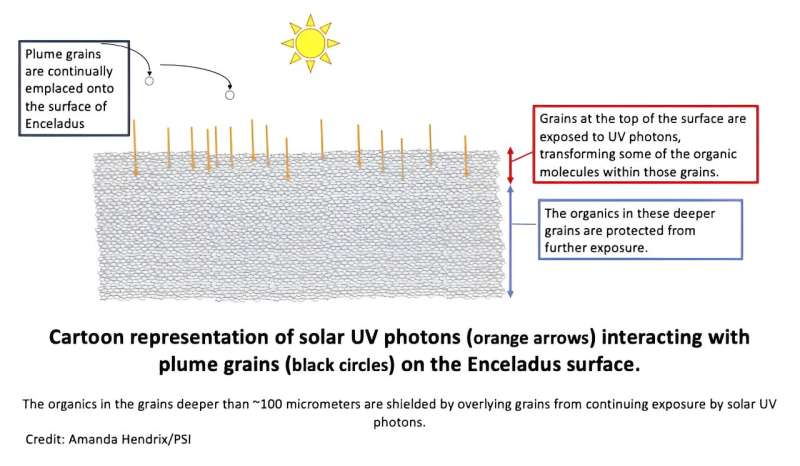This article has been reviewed according to Science X's editorial process and policies. Editors have highlighted the following attributes while ensuring the content's credibility:
fact-checked
peer-reviewed publication
trusted source
proofread
Surface of Saturnian moon Enceladus shields buried organics

The Saturnian moon Enceladus presents a unique opportunity in our solar system to search for evidence of life, given its habitable ocean and plume that deposits organic-bearing ocean material onto the surface.
A paper led by Planetary Science Institute Senior Scientist Amanda R. Hendrix says that an ample supply of relatively pristine plume organics could be measured by instruments sent to Enceladus' surface.
"We can learn a lot about potential biosignatures in Enceladus's ocean by sending a mission to the surface of Enceladus. Previously, it was thought that in order to sample the freshest material from the Enceladus ocean, you have to fly through the plume and measure plume grains and gases. But now we know that you can land on the surface and be confident that your instruments can measure relatively pristine plume organics—sourced from the ocean," said Hendrix, lead author of "Low effective ultraviolet exposure ages for organics at the surface of Enceladus," which appears in Communications Earth & Environment.
"We know that Enceladus's ocean is habitable thanks to Cassini measurements. We know there is liquid water, energy, and the chemicals carbon, hydrogen, nitrogen, oxygen, phosphorus and sulfur. These are the ingredients necessary for life as we know it," Hendrix said.
"Enceladus is an ocean world: It harbors a liquid ocean below an icy surface. There are at least several ocean worlds in our solar system, but Enceladus is special because it is spraying its ocean material out into space via its south polar vapor-and-ice grain plume, which means that the instruments on the Cassini spacecraft were able to characterize the ocean as the spacecraft flew by and through the Enceladus plume," Hendrix said.
"Luckily, for this study, even though some of the plume grains are ejected out into the Saturnian system, close to 90 percent of the plume grains fall back onto the surface of the moon, which likely means that ocean material—including organics—is sitting right on the surface."
Organic molecules found in the plume of Enceladus include molecules like methane (CH4) and ethane (C2H6), along with more complex molecules.
"Organics can be processed, or chemically transformed, by solar ultraviolet (UV) photons and by charged particles like electrons. But if we want to find out if any ocean-derived biosignatures are present in the plume grains, we need these grains to be as pristine and unexposed to UV as possible," Hendrix said.
In this study, Hendrix used data from the Hubble Space Telescope and Cassini spacecraft to estimate how deeply UV photons can penetrate into the plume grain-coated surface of Enceladus.
"What we find in this study is that there are places on Enceladus' surface where we could land with a spacecraft and take a sample—and we'd be measuring relatively pristine organics," Hendrix said. "That's because the solar ultraviolet (UV) photons just don't penetrate very deeply into the icy surface. Those damaging solar UV photons only penetrate some 100 micrometers into the icy surface. That's the width of a couple of human hairs.
"So that very top part of the surface gets exposed to those damaging UV photons, but only a percentage of the organics are chemically transformed, and then soon enough that material is covered up by fresher plume material. And the deeper grains don't undergo more transformation—because the UV photons are prevented from interacting with the deeper material. The freshly deposited plume grains act as a shield for the underlying material. They act like a sunscreen.
"Ideally, we want to one day sample relatively pristine ocean-derived organics by landing on the surface of Enceladus. This result is important because it tells us that there will be plenty of relatively pristine organics available to sample, because the penetration depth of those damaging UV photons is so shallow. The slightly deeper grains haven't been exposed much to the UV, so that means the organics have a low exposure age," Hendrix said.
"Because UV light readily alters organic molecules, the depth that such light travels into the surface of an ice-covered world really matters. With the short UV penetration depths found, our results ensure that there is ample organic material locked away and preserved in the ices of Enceladus that can be traced back to its ocean," said co-author Christopher House of Penn State University. "It is awe-inspiring to think that with known technology, we can readily access lots of organic material from a habitable extraterrestrial ocean."
More information: Amanda R. Hendrix et al, Low effective ultraviolet exposure ages for organics at the surface of Enceladus, Communications Earth & Environment (2023). DOI: 10.1038/s43247-023-01130-8
Journal information: Communications Earth & Environment
Provided by Planetary Science Institute





















